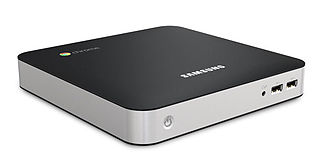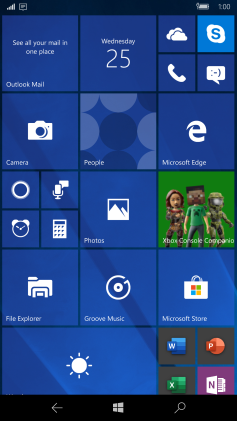Related Research Articles

A netbook is a small and inexpensive laptop designed primarily as a means of accessing the Internet. Netbooks were sold from 2007 until around 2013, when the widespread advent of smartphones and tablets eclipsed their popularity. Netbooks generally had lower-end hardware specifications than consumer laptops of the time, being primarily intended as clients for Internet services. While netbook has fallen out of use, these machines evolved into other products including Google's Chromebook, and mobile devices, particularly tablet computers, often running mobile operating systems such as iOS or Android.

A tablet computer, commonly shortened to tablet, is a mobile device, typically with a mobile operating system and touchscreen display processing circuitry, and a rechargeable battery in a single, thin and flat package. Tablets, being computers, have similar capabilities, but lack some input/output (I/O) abilities that others have. Modern tablets largely resemble modern smartphones, the only differences being that tablets are relatively larger than smartphones, with screens 7 inches (18 cm) or larger, measured diagonally, and may not support access to a cellular network. Unlike laptops, tablets usually run mobile operating systems, alongside smartphones.

Asus Eee is a family of products by AsusTek Computer Inc. The product family began with the release of the Eee PC subnotebook in 2007; since then, the product family has diversified into a number of PC form factors. According to the company, the name Eee derives from "the three Es," an abbreviation of its advertising slogan for the device: "Easy to learn, Easy to work, Easy to play".
The history of tablet computers and the associated special operating software is an example of pen computing technology, and thus the development of tablets has deep historical roots. The first patent for a system that recognized handwritten characters by analyzing the handwriting motion was granted in 1914. The first publicly demonstrated system using a tablet and handwriting recognition instead of a keyboard for working with a modern digital computer dates to 1956.

The Asus Eee Pad Transformer TF101 is a 2-in-1 detachable tablet developed by Asus that runs the Android operating system. It is the first tablet in the Asus Transformer Pad series. The Eee Pad Transformer features a 10.1-inch (260 mm) display, an Nvidia Tegra 2 dual-core chip, 1 GB of RAM, and 16 or 32 GB of storage. The tablet initially launched with Android 3.1, nicknamed "Honeycomb", but was updated to support Android 4.0.3.

A Chromebook is a laptop or tablet running the Linux-based ChromeOS as its operating system. Initially designed to rely heavily on web applications for tasks using the Google Chrome browser, Chromebooks have since expanded to be able to run Android and full-fledged Linux apps since 2017 and 2018, respectively. All supported apps can be installed and launched alongside each other.

A 2-in-1 PC, also known as convertible laptop, 2-in-1 tablet, 2-in-1 laptop, 2-in-1 detachable, laplet, tabtop, laptop tablet, or simply 2-in-1, is a portable computer that has features of both tablets and laptops.

A Chromebox is a small form-factor PC running Google's ChromeOS operating system. The first device debuted in May 2012.
Atom is a system on a chip (SoC) platform designed for smartphones and tablet computers, launched by Intel in 2012. It is a continuation of the partnership announced by Intel and Google on September 13, 2011 to provide support for the Android operating system on Intel x86 processors. This range competes with existing SoCs developed for the smartphone and tablet market from companies such as Texas Instruments, Nvidia, Qualcomm and Samsung. Unlike these companies, which use ARM-based CPUs designed from the beginning to consume very low power, Intel has adapted the x86-based Intel Atom line of CPU developed for low power usage in netbooks, to even lower power usage.

Windows RT is a mobile operating system developed by Microsoft. It is a version of Windows 8 or Windows 8.1 built for the 32-bit ARM architecture (ARMv7). First unveiled in January 2011 at Consumer Electronics Show, the Windows RT 8 operating system was officially launched alongside Windows 8 on October 26, 2012, with the release of three Windows RT-based devices, including Microsoft's original Surface tablet. Unlike Windows 8, Windows RT is only available as preloaded software on devices specifically designed for the operating system by original equipment manufacturers (OEMs).

The Post-PC era was a market trend observed during the late 2000s and early 2010s involving a decline in the sales of personal computers (PCs) in favor of post-PC devices; which include mobile devices such as smartphones and tablet computers as well as other mobile computers such as wearable and ubiquitous ones. These devices emphasize portability and connectivity, including the use of cloud-based services, more focused "apps" to perform tasks, and the ability to synchronize information between multiple devices seamlessly.

Microsoft Surface is a series of touchscreen-based personal computers, tablets, and interactive whiteboards designed and developed by Microsoft, most of them running the Windows operating system. They are designed to be premium devices that set examples for manufacturers of other Windows-compatible products. It comprises several generations of hybrid tablets, 2-in-1 detachable notebooks, a convertible desktop all-in-one, an interactive whiteboard, and various accessories, many with unique form factors. The majority of devices in the Surface lineup are based on Intel processors and compatible with Windows 10 or Windows 11.

VivoTab is a series of Microsoft Windows hybrid tablet computers designed by Asus. It is a sub-series of the Vivo series by Asus. The name is derived from the Latin word "to live" and, along with Asus's Transformer series of convertible devices running Windows, is a primary competitor to the Microsoft Surface.

The Samsung Ativ Q was a 13.3-inch convertible laptop to be manufactured by Samsung. Unveiled at a Samsung Premiere event on June 20, 2013, the tablet was to run Windows 8, but also shipped with software that also allowed it to run the Android operating system. The Ativ Q's hardware was also distinguished by multiple folding states and a high resolution display.

The Surface Pro 2 is a Surface-series 2-in-1 detachable produced by Microsoft. Unveiled at an event in New York City on September 23, 2013 and released on October 22, 2013, it succeeds the Surface Pro released in February 2013. While maintaining a design similar to the original design of its predecessor, the Surface Pro 2 has improved hardware specifications compared to it, such as a Haswell Intel Core processor and an increased number of storage options, improved versions of the kickstand and cover accessories.
Asus Transformer is a series of 2-in-1 convertibles, detachables and hybrid tablet computers, designed and manufactured by Asus, consisting of three major lineups.

ASUSTeK Computer Inc. is a Taiwanese multinational computer, phone hardware and electronics manufacturer headquartered in Beitou District, Taipei, Taiwan. Its products include desktop computers, laptops, netbooks, mobile phones, networking equipment, monitors, wi-fi routers, projectors, motherboards, graphics cards, optical storage, multimedia products, peripherals, wearables, servers, workstations and tablet PCs. The company is also an original equipment manufacturer (OEM).

Windows 10 Mobile is a discontinued mobile operating system developed by Microsoft. First released in 2015, it is a successor to Windows Phone 8.1, but was marketed by Microsoft as being an edition of its PC operating system Windows 10.
The Pixelbook is a portable laptop/tablet hybrid computer developed by Google which runs ChromeOS. It was announced on October 4, 2017, and was released on October 30. In September 2022, Google canceled future generations of the product and dissolved the team working on it.
The Surface Neo is an unreleased dual-touchscreen 2-in-1 PC that was unveiled by Microsoft on October 2, 2019. Slated to be part of the Microsoft Surface family of devices, the Surface Neo was designed to be used in various "postures" for different use cases and multitasking scenarios involving its screens, and feature Windows 10X—a variant of Windows 10 designed exclusively for dual-screen devices.
References
- 1 2 "Microsoft and Google ruin Intel's plan for dual-OS tablets". The Verge . Mar 14, 2014. Retrieved 30 March 2017.
- 1 2 3 4 Swamy, Rohan (7 January 2014). "CES 2014: Asus Transformer Book Duet launched with dual-boot Android, Windows". New Delhi Television Limited. Retrieved 7 January 2014.
- 1 2 3 4 Ingraham Nathan (6 January 2014). "The Asus Transformer Book Duet hybrid can instantly switch between Windows and Android". The Verge. Retrieved 6 January 2014.
- 1 2 3 4 "Asus Transformer Book Duet Dual Boots With Windows 8.1, Android". PCmag. 6 January 2014. Retrieved 7 January 2014.
- 1 2 3 Limer Eric (6 January 2014). "Asus Transformer Book Duet: One Laptop, Two Tablets, All The Crazy". Gizmodo. Retrieved 6 January 2014.
- ↑ Osborne Joe (6 January 2014). "Asus Transformer Book Duet is a hybrid laptop in more ways than one". techradar pro. Retrieved 11 January 2014.
- 1 2 Mack, Eric (11 January 2014). "ASUS' Transformer Book Duet: Home to both Android and Windows 8.1". Gizmag. Retrieved 12 January 2014.
- 1 2 3 Cunningham, Andrew (8 January 2014). "Hands-on: Asus' Transformer Book Duet and the clunky "Dual OS" feature". ars technica. Retrieved 11 January 2014.
- ↑ Summerson, Cameron (7 January 2014). "Hands On With The ASUS Transformer Book Duet". Android Police. Retrieved 11 January 2014.
- 1 2 "Asus Transformer Book Duet TD300 tablet/laptop hybrid runs Windows 8.1 and Android". CNET. 6 January 2014. Retrieved 7 January 2014.
- ↑ Griffiths Daniel (7 January 2014). "Asus Announces Transformer Book Duet - Windows And Android, Together At Last. Wait, What?". Forbes. Retrieved 7 January 2014.
- ↑ Savov Vlad (7 January 2014). "The Transformer Book Duet combines Windows with Android, tablet with laptop". The Verge. Retrieved 7 January 2014.
- ↑ "Microsoft and Google ruin Intel's plan for dual-OS tablets". The Verge. 14 March 2014. Retrieved 17 March 2014.
- ↑ "Google and Microsoft are out to stop dual-boot Windows/Android devices". Ars Technica. 14 March 2014. Retrieved 17 March 2014.
- ↑ "Intel plans a CES coup: Android and Windows in the same computer". The Verge. 3 January 2014. Retrieved 17 March 2014.
- ↑ "Google's iron grip on Android: Controlling open source by any means necessary". Ars Technica. Retrieved 2013-12-08.